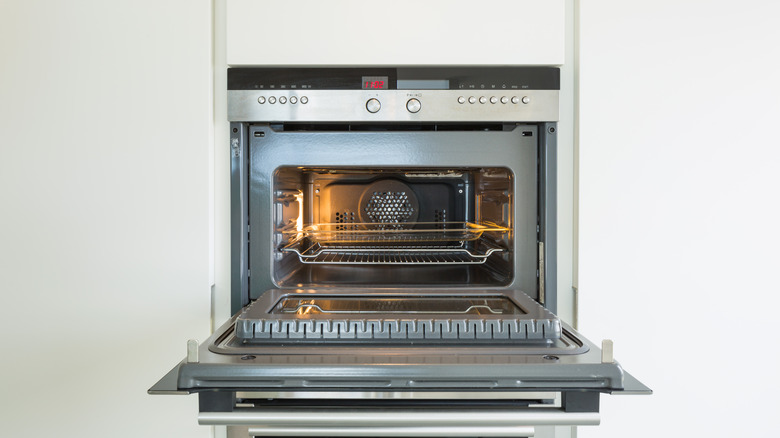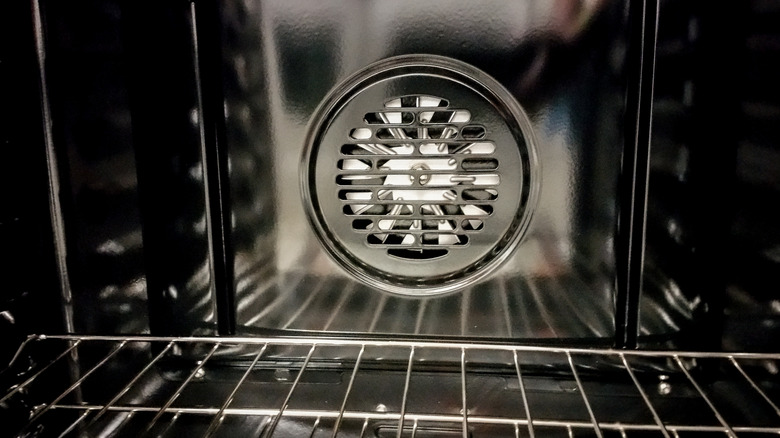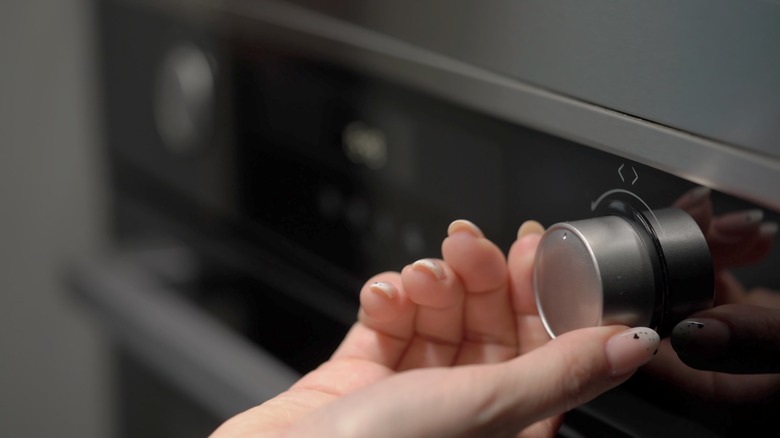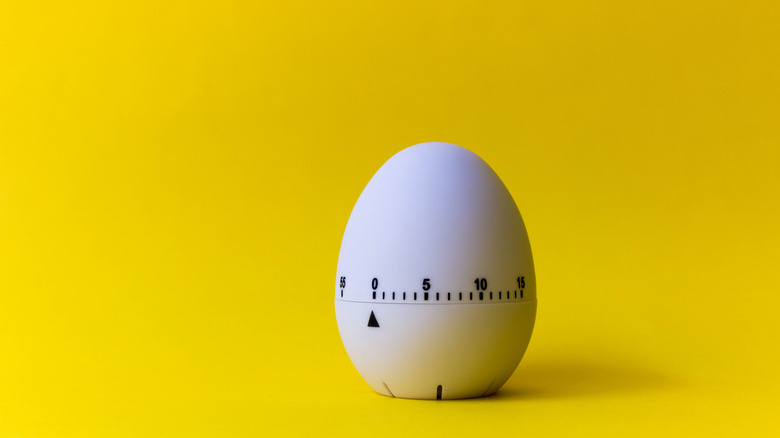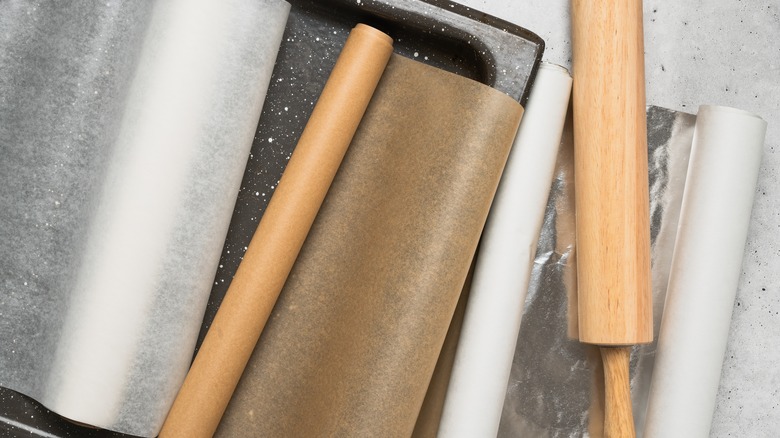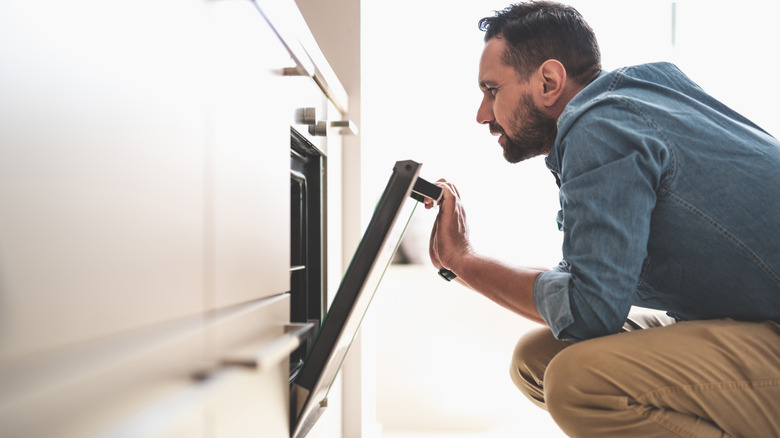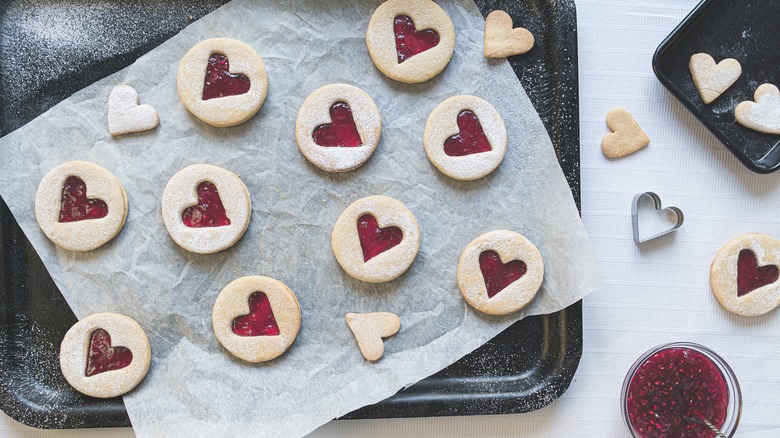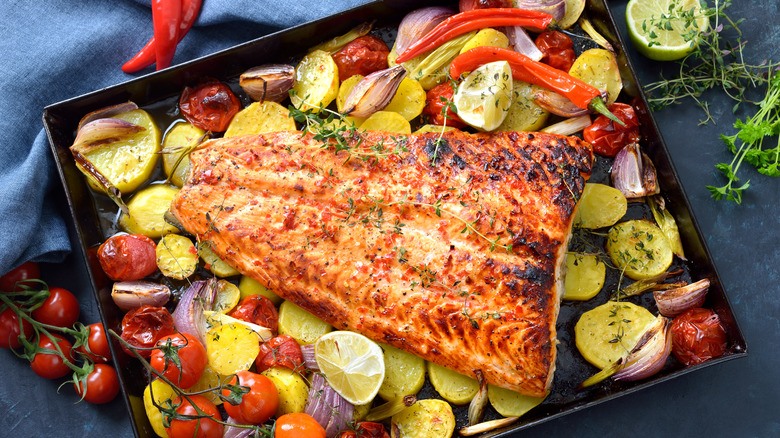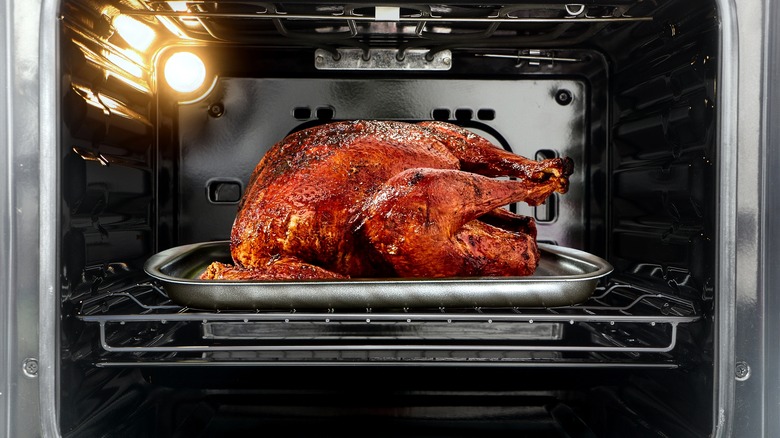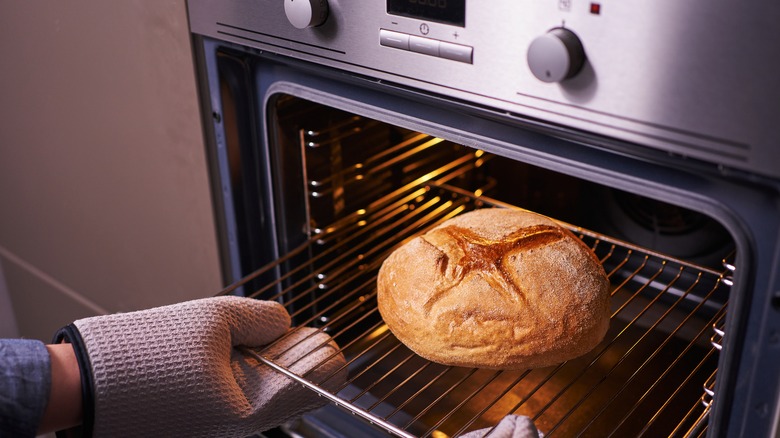The 10 Biggest Mistakes Everyone Makes When Cooking In A Convection Oven
Convection ovens have grown in popularity over the years, but did you know this appliance is relatively new? Archaeological evidence documents the use of wood-fired ovens by the ancient Egyptians (via Smithsonian Magazine). Gas and electric ovens did not come to the scene until the 19th century, but it was not until the 1960s that the convection oven emerged in the market.
First engineered by the Malleable Iron Range Company, a convection oven uses a fan to circulate hot air to cook food, as opposed to a conventional oven that uses a heating source to heat the air inside the oven (via Chicago Tribune). They believed that this technology could heat food more evenly than conventional ovens. However, these ovens were primarily only found in professional kitchens due to their high cost. Now, reasonably priced models exist, making this a more attainable choice for home kitchens. This technology is in even more homes now, as air fryers are basically compact convention ovens. The convection oven walked so air fryers could run.
If you are new to convection cooking, or even if you think you understand convection ovens, there are a number of tips and tricks to get the most out of this appliance. Avoid these mistakes, and you will be on your way to mastering the art of convection cooking (and baking).
Choosing the wrong setting
Conventional ovens have fairly straightforward instructions. Unless you are using the broiler, you set your oven to the desired temperature, and it will start to pre-heat. With convection ovens, you also will set a temperature, but there are additional settings to consider.
Convection ovens may only have one fan setting, but some models will have two (via The Army Quartermaster Corps). The high and low settings correspond to the speed it blows air. If your oven does have more than one option, choosing the best one can make a huge difference in your cooking. For some applications, using the high fan speed could be akin to melting chocolate in the microwave at full power (which is highly discouraged due to the likelihood of burning the chocolate).
The Army Quartermaster Corps. advises against using the high setting for cakes, muffins, pies, etc., as it can damage these baked goods. Cooking bacon is also best on the low setting for safety reasons: You don't want to blast hot fat all over your oven, according to the manual. If your recipe is not written for a convection oven or doesn't specify a setting, the safest bet is the low fan speed in most applications.
The exception is roasting meats like a whole chicken. In that case, we find the high fan setting allows for better browning.
Not lowering the oven temperature
One of the biggest mistakes people make when using a convection oven is not adapting recipe instructions to account for the differences between conventional and convection ovens. Most publicly available recipes were written for a conventional oven because that is what most people had in their homes.
One of the benefits of convection ovens is that the air circulation leads to more even cooking, but you have to be careful. The air inside convection ovens generally gets hotter than in conventional ovens. You may think this means you can just cook things faster, but the truth is not that simple. Convection ovens can lead to food browning too quickly. This is particularly of concern when baking cookies and cakes, where the outside could burn before the inside is done baking.
The most common guidance is to reduce the oven by 25 degrees when using convection settings. However, you should also consult the manufacturer's instructions for your oven. In our experience, some brands may recommend lowering the temperature by up to 50 degrees.
Not decreasing cooking or baking time
Even after lowering the oven temperature, convection ovens will still cook faster than conventional ovens. Quicker, more even cooking is its claim to fame. It is understandable why these ovens have been so favored in commercial bakeries. Time is money, after all.
So, how much time can you save by using a convection oven? It is estimated that convection ovens can reduce your cook and bake times by up to 25%. Think of how many more cookies you can make with those time savings!
Shorter cook times mean you will need to check on the contents of your oven earlier than with standard ovens. If you are accustomed to conventional ovens, you'll want to err on the side of caution when trying even familiar recipes. Check the oven at least 5 minutes sooner than you typically would until you get acquainted with the convection setting on your oven. With experience, you will be able to better predict cook and bake times.
Not securing the parchment paper
Picture this: You put a sheet tray of cookies in the convection oven, and you walk away. When you come back to check on the progress, you see that your cookies have toppled over on the tray and are now mashed and ruined. What went wrong? The trouble is with parchment paper. A convenient item for baking, parchment paper is incredibly lightweight. The fan in your convection oven can easily cause parchment paper to lift and possibly toss your baked goods around on the trays. Given how fragile items like cookies are while baking, it is crucial that they do not blow around like inside a wind tunnel.
If you crowd-source for a solution, you'll find a range of suggestions, from securing the corners with metal binder clips to weighing down the parchment with butter knives. Those options may work, but they could take away valuable real estate on your sheet tray.
A little-known trick from experienced bakers is to place a tiny bit of your batter (whether that be cookie dough, meringue, or choux paste) on all four corners of the sheet tray, according to Chef Talk. When you secure the parchment to the batter, it will act as glue, and the paper will stay in place, says the site. Don't worry though: It's easy to remove the parchment afterward.
Never rotating your pans
In a true convection oven with proper air circulation, you shouldn't need to rotate your pans: There shouldn't be any "hot spots." Even in convection ovens, it is still a best practice to rotate your pans during cooking. In reality, these appliances are not 100% reliable, and most likely, there will be some hotter areas in your oven.
The act of flipping pans in the oven has scientific backing. Large pans and sheet trays can block the airflow from evening reaching your food. Rotating helps ensure that the hot air can hit a better surface area. Halfway through your cooking or baking time, flip your baking pans 180 degrees from front to back. Additionally, if you are baking on multiple racks, make sure to switch the trays on the racks as well. This way you can feel confident your food will have the most balanced cooking conditions.
Opening the oven too much
We understand how hard it is to resist opening the oven while cooking, especially when baking. When the smell of freshly baked cake or cookies fills your kitchen, it is so tempting to sneak a peak at your masterpiece. However, this is a crucial error with any type of oven. Chef Andrew Zimmern explained on "The Rachael Ray Show" in 2018 that every time you open your oven, you lose about 50% of its heat, which can impact your cooking process.
Don't open the oven until you are ready to rotate your baking sheets halfway through the total time, and then try to leave it closed until you think the food should be ready. If you do want to check again, look through the oven door, if you have one, and use the light if necessary. If you do need a closer view, it is better to quickly remove your baking sheet and close the oven door than to keep the tray on the rack with the oven door open while you inspect your food. This will minimize heat loss.
Using high-sided pans
Airflow is a critical part of convection cooking. Convection ovens can get your food browner and crispier than a conventional oven, but they cannot accomplish this if the air cannot reach the food. For best results, use low-sided pans in a convection oven. Deep-sided pans, such as roasting pans with high walls, can block the airflow, preventing the skin from crisping.
For both presentation and flavor, roasted meats benefit from browning. This process, called the Maillard reaction, is a chemical reaction that occurs when sugars and amino acids in proteins caramelize, changing the color and flavor of the meat. When roasting in a convection oven, a low-sided sheet tray fitted with a wire rack is preferable to one of those big roasting pans, even if makes for a cool presentation.
Even for baking cookies, shallow sheet trays are better than ones with a bit of a lift to them. Although you don't want to burn your cookies, the Maillard reaction brings a more complex flavor out of the sugars. If your cookies can't brown, you won't get the full enjoyable experience.
Covering the food
Multiple factors could prevent the Maillard reaction from occurring in a convection oven. Overcrowding the oven can block airflow. However, one thing you almost never want to do in a convection oven is cover your food. Whether it is a lid on a roasting pan or a layer of foil on a baking dish, covering your food will shield it from the hot air and prevent browning. The best part of a big dish of baked macaroni and cheese is the crunchy layer of cheese or breadcrumb topping, which won't happen if the dish is covered.
In some circumstances, you may want some protection for your food from the hot air. The top of a casserole might brown too much before the center is warmed, or long-roasting meat could dry on the outside before the desired internal temperature is reached. In these cases, it is okay to use foil to cover your food for the first part of cooking. Just make sure to leave time towards the end to achieve the browning you desire. Keep in mind that with a convection oven you are far less likely to see meats dry out compared to conventional ovens. If you are someone who likes your food more on the dark side, you might not even want to cover meats and casseroles at all.
Baking everything in a convection oven
Convection ovens work more efficiently than conventional ovens, so you should just cook everything in them, right? Well, not quite. If you're deciding when to use your convection oven, the setting is well-suited for roasting meats, browning casseroles, and baking cookies and other baked goods where you desire even browning. Puff pastry is an excellent example, especially for desserts like mille-feuille where you want a crispy pastry. If you want to see brown, a convection oven is your friend.
These ovens are not the best choice when it comes to baking cakes, meringues, and custards, including cheesecake. Baking a cake in a convection oven could result in the outside being cooked while the inside is still raw. Meringues can end up with a beige hue inside of glossy white, and cheesecakes might dry out instead of having their signature silky texture. The good news is that most convection ovens in home kitchens give you the option of turning the convection feature off. You can get the best of both worlds by picking and choosing when to fire up the fan.
Not using the steam feature
This last faux pas does not apply to all convection ovens, but it is still worth mentioning. Some convection ovens have a steam feature, and you are certainly missing out if you do not use it. Convection steam ovens will simultaneously brown your food through air circulation while using steam to lock in moisture (via Atherton Appliance). This feature is ideal because steam plays an important role in baking bread. First, steam helps aid the last stage of fermentation, called the "oven-spring." This occurs when the yeast in the bread dough releases one final round of gas that causes the loaf to rise in the oven. Once the water evaporates, the convection feature will trigger the Maillard reaction, which forms the brown crust.
If you do not have one of these handy convection steam ovens, you can still achieve the perfect crusty loaf. King Arthur Baking suggests three methods for injecting steam into your oven: The easiest method is probably to spray water from a squirt bottle onto your shaped dough before putting it in the oven, followed by a second spray five minutes into baking.
Alternatively, you can pre-heat the oven with a cast iron pan in the bottom and pour in 1 cup of boiling water when you put the dough in the oven. The final method is to bake your bread in a pre-heated Dutch oven, which will create steam with the lid in place.
